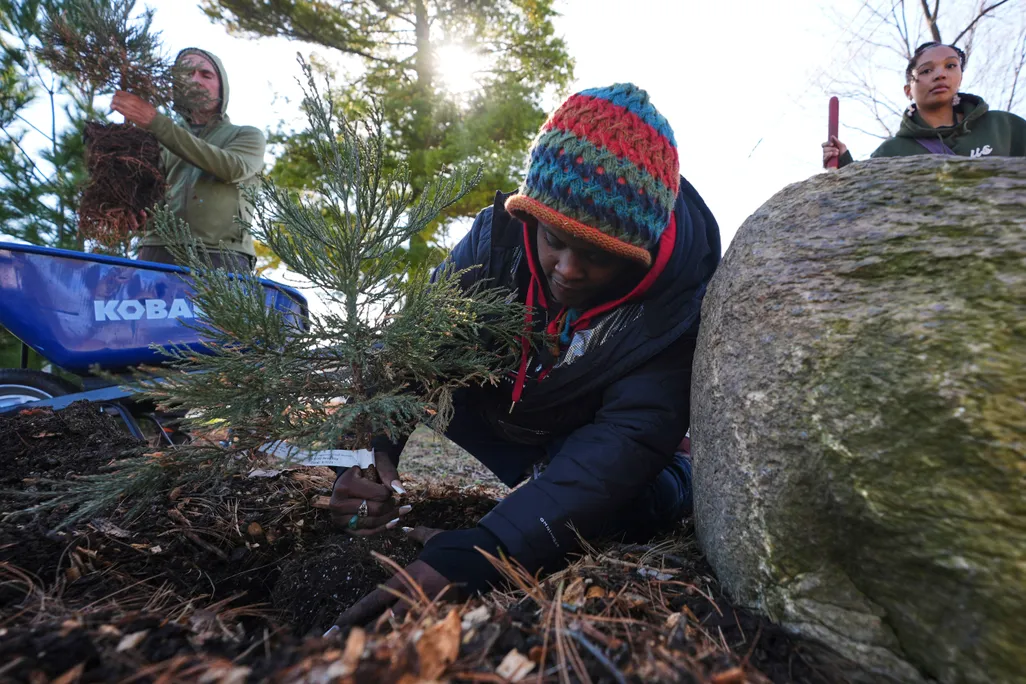WWW.SMITHSONIANMAG.COM
Giant Sequoias Are Taking Root in an Unexpected Place: Detroit
Giant Sequoias Are Taking Root in an Unexpected Place: Detroit
Arborists are planting urban groves of the world’s largest trees in one of the city’s most blighted neighborhoods
Arborists are reforesting Detroit's Poletown East neighborhood with giant sequoias and other species of trees.
AP Photo / Paul Sancya
Giant sequoias are typically found in California’s Sierra Nevada mountain range, where they reach heights of up to 300 feet.
Now, however, with help from conservationists, the world’s largest trees are spreading to new places. In Detroit, arborists are planting dozens of giant sequoia saplings in a blighted area in hopes of creating an urban forest that will clean the air, provide shade and, overall, improve residents’ quality of life.
The trees are being planted in Detroit’s Poletown East neighborhood through a partnership between two nonprofits, Arboretum Detroit and Archangel Ancient Tree Archive.
The effort started in 2020 and 2021, with the planting of 20 giant sequoia trees on private property and vacant lots owned by Arboretum Detroit. It continued late last month, as volunteers convened on Earth Day to plant roughly 100 additional saplings.
“There’s not another urban area I know of that has the kind of potential that we do to reforest,” says Andrew “Birch” Kemp, co-director and board president of Arboretum Detroit, to the Associated Press’ Corey Williams. “We could all live in shady, fresh air beauty. It’s like no reason we can’t be the greenest city in the world.”
The Earth Day saplings are roughly a foot tall. But, if all goes as planned, they’ll rocket to roughly 15 feet tall—and counting—over the next decade. The trees can grow up to two feet each year.The saplings are all clones of two well-known trees in California. One is the Amos Alonzo Stagg tree, which measures 243 feet tall. Nicknamed “Stagg” for short, the tree is the fifth-largest in the world. The other, known as Waterfall, had the largest ground perimeter of any giant sequoia, 140 feet, before it was killed in a 2020 wildfire, reports MLive.com’s Justine Lofton.
The clones were developed by experts with Archangel Ancient Tree Archive, which traveled to California to gather the trees’ cones and new-growth clippings in 2010. The group is working to propagate and preserve the world’s old-growth trees at its headquarters in Northern Michigan, as well as in “living libraries” around the world.
Giant sequoias are not native to Michigan. And, yet, they’re somehow thriving in the state, which has a much cooler and wetter climate than their native California.
The biggest giant sequoia east of the Rockies is a 77-year-old specimen, called the Michigan Champion, that was planted in 1948 on the eastern shores of Lake Michigan. The tree measures roughly 116 feet tall and 5 feet in diameter.
“They’re safer here ... we don’t have wildfires like [California],” Kemp tells the Associated Press. “The soil stays pretty moist, even in the summer. They like to have that winter irrigation, so when the snow melts they can get a good drink.”
Meanwhile, experts say some native trees—including hemlock, elm and beech—are struggling in the city. In addition to the giant sequoias, Arboretum Detroit is also planting roughly 80 other species of trees in the neighborhood.
“We’re planting the forest of the future,” Kemp tells MLive.com. “Diversity is the answer. There are so many natives that aren’t happy here anymore. We have to look at what trees are thriving.”
The overarching goal is to reforest an area of Detroit that’s full of vacant lots, abandoned homes, an automobile assembly plant, a former incinerator and two interstates. The University of Michigan describes Poletown East as “arguably one of the most blighted neighborhoods in Detroit.”Arborists expect the giant sequoias to reduce air pollution and lower the temperature in the neighborhood, which Kemp describes as a “heat island.” The trees will also sequester carbon dioxide.
Arboretum Detroit has also created a network of parks to help revitalize the area.
“We live in pretty much a pollution hotspot,” Kemp tells the Associated Press. “We’re trying to combat that. We’re trying to breathe clean air. We’re trying to create shade. We’re trying to soak up the stormwater, and I think sequoias—among all the trees we plant—may be the strongest, best candidates for that.”
Since giant sequoias can live for thousands of years, they’ll likely outlive the individuals who planted them. To help protect and care for them in the future, the groups are working with Detroit school children to encourage them to become stewards of the city’s urban forests. They call this educational effort “propagating the propagators.”
And Detroit is just the beginning. Archangel Ancient Tree Archive also wants to plant sequoias in Los Angeles and Oakland, California, as well as in London.
“This isn’t just reforestation—it’s a revolution,” says David Milarch, co-founder of Archangel Ancient Tree Archive, in a statement. “This project proves we can rebuild ancient forests and a better future even in the most unexpected places.”
Get the latest stories in your inbox every weekday.
